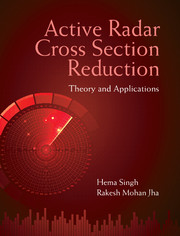Book contents
- Frontmatter
- Dedication
- Contents
- List of Tables
- List of Figures
- List of Abbreviations
- Preface
- Acknowledgements
- 1 Introduction to Radar Cross Section Reduction
- 2 RAM Analysis for Low-Observable Platforms
- 3 Radar Cross Section of Phased Antenna Arrays
- 4 Active RCS Reduction in Phased Arrays
- 5 Mutual Coupling Effects in Phased Arrays
- 6 RCS of Dipole Array Including Mutual Coupling Effects
- 7 Performance of Sidelobe Cancellers in Active RCSR
- 8 Emerging RCSR Techniques
- Epilogue
- Appendices
- List of Symbols
- Suggestions for Further Reading
- Author Index
- Subject Index
4 - Active RCS Reduction in Phased Arrays
Published online by Cambridge University Press: 05 April 2015
- Frontmatter
- Dedication
- Contents
- List of Tables
- List of Figures
- List of Abbreviations
- Preface
- Acknowledgements
- 1 Introduction to Radar Cross Section Reduction
- 2 RAM Analysis for Low-Observable Platforms
- 3 Radar Cross Section of Phased Antenna Arrays
- 4 Active RCS Reduction in Phased Arrays
- 5 Mutual Coupling Effects in Phased Arrays
- 6 RCS of Dipole Array Including Mutual Coupling Effects
- 7 Performance of Sidelobe Cancellers in Active RCSR
- 8 Emerging RCSR Techniques
- Epilogue
- Appendices
- List of Symbols
- Suggestions for Further Reading
- Author Index
- Subject Index
Summary
Introduction
Active radar cross section reduction (RCSR), i.e. active stealth technology relates to phased arrays and involves rejection of unwanted signals incident on aircrafts or missiles from different angles and simultaneous maintenance of distortion-less gain towards the signals from desired sources. This has additional advantages over the existing passive techniques for signature reduction, viz. shaping and coatings (Vinoy and Jha 1996). Moreover, it does not face difficulties in rejection of wideband and multiple targets incident from hostile sources.
Phased arrays consist of a large number of antenna elements, such as dipoles or waveguides, each of which is fed from a distribution network (Mailloux 1994). Depending on the spacing between elements and the relative phase of their excitation, the net radiation pattern can be steered in any direction without any mechanical motion of the array itself. Since this is done electronically, very high scan rates can be achieved. The main advantages of phased array are rapid electronic-beam steering and adaptive control of radiation pattern. In antenna arrays, effect of the probing signals can be removed/cancelled if a sufficient deep null is created in its radiation pattern towards the impinging angle of hostile radar. If this is done automatically, then such an array is referred to as adaptive array.
An adaptive array is an array of antennas and receiver with a real-time adaptive signal processor. The array follows the beam-steering command, maintaining the gain in the desired directions (Elliot 2005). Moreover, it adapts the weights to control the magnitude and phase of the feed current of each array element towards optimisation. Adaptive arrays may be used for active cancellation of probing effect of hostile radars. The adaptive algorithms employed for weight adaptation play an important role in controlling the performance indices of phased array.
An array comprises a set of sensors, the outputs of which are combined in some way to produce a desired effect. The sensors may be of many forms, for example, acoustic transducers for sonar, monopulse antennas for HF reception and microwave horns in a radar system.
Information
- Type
- Chapter
- Information
- Active Radar Cross Section ReductionTheory and Applications, pp. 126 - 176Publisher: Cambridge University PressPrint publication year: 2015
